
NIST’s Real Impact on Innovation and Quality of Life
Page menu
Measurements are key to scientific and technological innovation. It’s like a field of dreams: Better measurements always find useful applications.
Proving this credo, NIST's nearly 120 years of research to advance measurement science, standards and technology have had significant impacts on American innovation and quality of life.
This is remarkable for a small federal agency focused on developing practical solutions to the nation’s ever-changing technology needs.
“NIST has the broadest science and technology portfolio of any science agency in the United States and likely in the world,” says Walter G. Copan, under secretary of commerce for standards and technology and NIST director.
Since becoming director of NIST in 2017, Copan has been impressed by the widespread respect for and trust in NIST, as evidenced at a July 2018 media-sponsored event attended by representatives of industry and the U.S. Congress.
“Every one of them walked up to me and said, ‘We love NIST,’” Copan says. “NIST provides tremendous value to the nation.”
One senator reported walking along the Florida seashore and seeing buildings that had collapsed during a hurricane, located side by side with others still standing — standing because they were built to comply with NIST-recommended codes and standards.
What is the true value of something like that? Measurement advances can have a human impact that goes beyond numbers.
Copan notes that NIST has a history of generously “giving things away,” and as a result is not always recognized as the source of an innovation. He aims to fix that through an ambitious effort that will make it easier for even more NIST innovations to make it out into the real world and for the country to get a bigger return on all federal investment in research and development.
Valuing the Invaluable
NIST’s impacts are often so broad or deep that they can’t be fully measured. Some NIST technologies are used by most Americans, may form the basis for new products or even industries, and can even save lives. Although there is no comprehensive dataset of NIST’s impacts, history offers many examples. Below are a few highlights.
NIST was a leader in the early days of radio, pioneering, among other things, the instrument (or blind) landing system. Anyone who has flown on an airplane at night or in cloudy weather, when the pilot can’t see much, can thank NIST for this system. Blind landing relying on radio guidance also provides the basis for today's air traffic control systems.
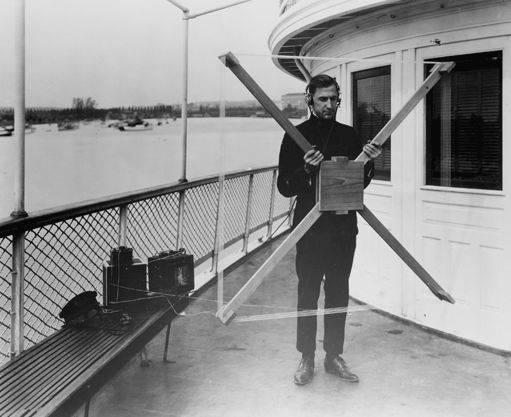
This photo was probably taken during an early (circa 1921) test of a radio direction finder (RDF), a special antenna that determined the direction of radio transmissions. The original RDF was made by an Italian team, but NIST researchers patented an improved design, built in 1916. It served as a prototype for the U.S. Navy and was used widely to pinpoint the positions of enemy forces during World War I.
NIST has long maintained U.S. civilian time standards, which support everyone who keeps a schedule, uses a phone or electricity, or owns stocks. NIST’s Internet Time Service responds to about 40 billion automated requests per day to synchronize clocks in computers and network devices, while NIST radio broadcasts update an estimated 50 million watches and other clocks daily. NIST official time supports the time-stamping of hundreds of billions of dollars in U.S. financial transactions each working day.
Another pervasive NIST technology is closed captioning. Originally called TvTime, a method for broadcasting time and frequency data on television, this Emmy Award-winning technology has greatly benefited the deaf and hard of hearing. It is widely used on television and cable programs as well as motion pictures and has spawned an industry of suppliers of closed captioning services.
NIST benefits public health and safety in many ways. NIST engineering studies of fires and structural failures have led to significant changes in practices, standards and codes to enhance the health and safety of the public.
NIST Innovator: Erica Kuligowski

Sociologist Erica Kuligowski develops live-saving procedures that can’t be patented but have earned her five NIST/Department of Commerce medals for infusing social science perspectives into improving disaster preparation and response.
“Some emergency planning and response is not as grounded in the social science data as it could be,” Kuligowski says. “There is often a disconnect between research findings and the implementation of these findings. So, one of the things I have been trying to do is take the research and systematically work to develop guidance for practitioners.”
For example, she was part of a 10-year effort to collect video of stairway evacuation drill speeds and flow from 14 different high-rise buildings. This dataset, with analysis of more than 22,000 measurements, is the first of its kind for use by engineers, architects, researchers, building owners and others involved in developing safer and cost-effective building designs and emergency procedures. The 2015 NIST report has been downloaded nearly 9,000 times (as of Fall 2018).
This work led to a collaboration with the Fire Protection Research Foundation to develop guidance for building owners, managers and engineers to more effectively communicate fire emergencies and evacuation/shelter instructions to building occupants. The resulting guidance was included directly (word for word) in Annex G Guidelines for Emergency Communication Strategies for Buildings and Campuses of the National Fire Alarm and Signaling Code (NFPA 72).
Kuligowski also studied public response to emergency communications in the 2011 tornado in Joplin, Missouri. The final report led to 16 recommendations, and her follow-up work included publishing guidance on the development of public alerts such as outdoor warning systems and wireless emergency alerts and Twitter messages. The guidance is included in a new Annex (Annex K Emergency Communications: Public Alerts and Warnings in Disaster Response) to NFPA 1600 (Standard on Continuity, Emergency, and Crisis Management).
Everyone also benefits from NIST data on improved refrigerant chemicals, which contributed to healing the atmospheric “ozone hole,” thus helping to lower the risk of skin cancer. And food and pharmaceuticals are safer thanks to NIST’s more than 1,000 different Standard Reference Materials, or SRMs, ranging from peanut butter to cancer drugs. These SRMs are used to calibrate and evaluate industry instruments and processes to make sure measurements are accurate.
NIST essentially invented the field of forensic science and continues to advance the field today. In one example of compelling but intangible benefits, NIST scientists helped develop and provide advice on the use of miniSTR technology for successful analysis of degraded DNA from mass disasters and other forensic cases. MiniSTRs helped identify victims of the 9/11 terrorist attacks on the World Trade Center.
NIST has long been a leader in safeguarding data. NIST developed the Advanced Encryption Standard, which has been used for nearly 30 years to encrypt and decrypt electronic information such as classified data, bank transactions and online shopping orders. In addition, to help strengthen cybersecurity for critical national infrastructure, such as banking and the energy supply, NIST created a cybersecurity framework that has been downloaded more than half a million times since its initial publication in 2014 and has been translated into four languages.
“The NIST Framework has proved itself through broad use by the business community. Among the sectoral associations that have incorporated the framework into cybersecurity recommendations are auto manufacturers, the chemical industry, the gas industry, hotels, water works, communications, electrical distribution, financial services, mutual funds, restaurants, manufacturing, retail sales, transportation, and corporate directors.” —U.S. Chamber of Commerce, May 2017
NIST pioneered a now-commonplace technique for measuring antennas used on radar, satellite dishes and now next-generation 5G wireless communications devices. The near-field method uses complex mathematical models to determine antenna properties and calculate performance at long distances — where it counts — using data collected more easily indoors, close to the antenna. There are now about 1,000 antenna ranges making near-field measurements throughout the world. The method saves space, time and money. NIST continues to innovate and transfer antenna range technology to industry.
Economic Impact Studies
Many studies have been conducted on the economic impact of specific NIST programs. Collectively, they can be viewed as an indicator of NIST’s impact on industry.
The latest published economic study, of the Advanced Encryption Standard, estimated that the program’s benefit-to-cost ratio is 1,976 to 1 for the whole U.S. economy. That is, every $1 invested generated $1,976 — a huge payoff for the nation. The assessment, conducted by an independent research group, covers the period 1996 to 2017. Overall, the standard has had an estimated economic impact of $250 billion.
From 2000 to 2011, 16 economic impact studies were conducted on individual NIST research programs spanning a range of technologies, from pharmaceuticals to electronics. These studies found a median benefit-to-cost ratio of 9 to 1.
Sometimes dollar benefits can be assigned to specific NIST projects based on readily available facts rather than formal study or surveys. The U.S. Mint estimates that it saves more than $2 million a year thanks to a NIST process for measuring lubricant films on coins — money that virtually everyone uses.
Additional economic studies (see pages 27-29 at the link) of NIST’s and other federal agencies’ impact are ongoing. For example, one study that was just completed assessed the economic impact of the Global Positioning System (GPS). The report shows how GPS resulted from federal innovation and technology transfer to the private sector, contributing to the tools of Americans’ everyday lives.
Patents, Licenses and Cooperative Agreements
Patents and licenses are classic measures of technology transfer. NIST researchers often invent technologies that are patented and then licensed by industry for possible commercialization. More than 650 patents have been obtained by more than 450 current NIST staff members. NIST currently has 55 active patent licenses, of which 25 are commercial licenses.
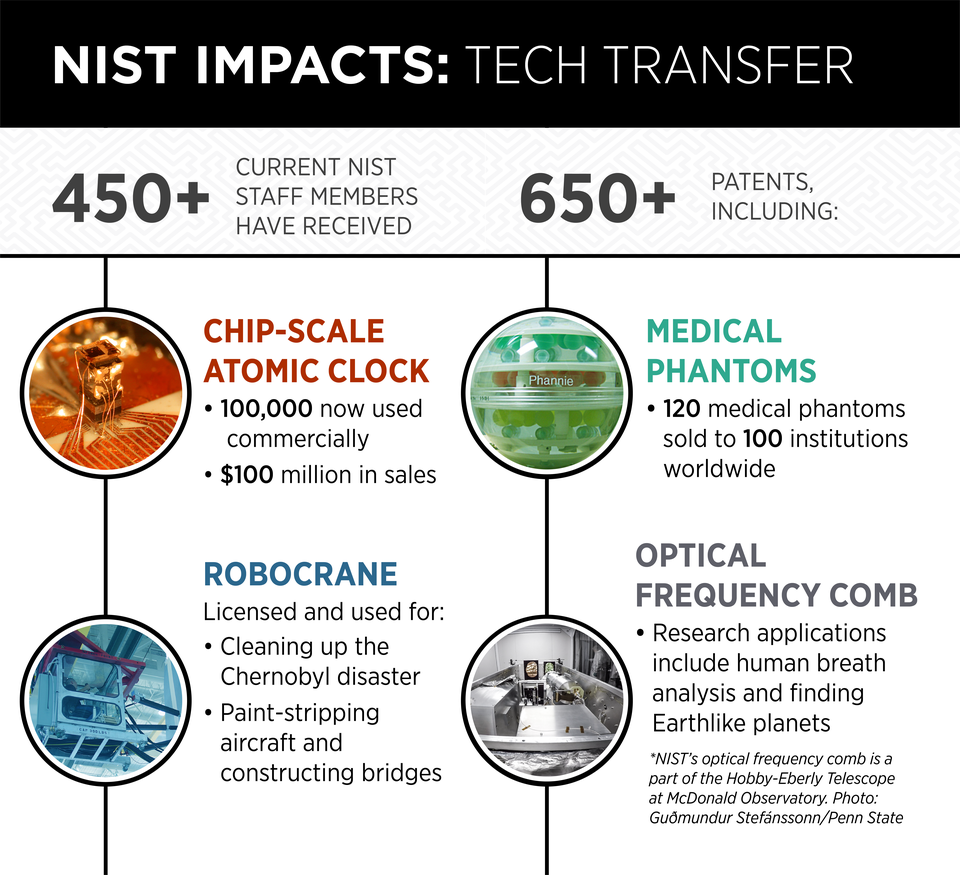
Unfortunately, it’s often difficult to use patent and license data to trace advancements in the lab to products on the market. One challenge is that licenses are generally considered to be confidential business information. By federal law (35 USC § 209 [d][f]) they are protected from disclosure so that companies can develop their products without giving away information that a competitor could exploit.
Still, those connections to patents derived from federally funded research that can be made public show a long history of important, real-world impact.
For example, NIST’s patented RoboCrane, developed in the 1990s to lift and precisely manipulate heavy loads in all six degrees of freedom, has been licensed and used for cleaning up the Chernobyl disaster site, in addition to applications such as paint-stripping aircraft and bridge construction.
Other products are in the pipeline. For example, NIST’s portable radiocarbon analyzer has been licensed for planned use across forests and cities to distinguish naturally occurring carbon from gases derived from fossil fuels.
It can take many years for a technology to achieve a clear, positive impact. The optical frequency comb, a “ruler of light” invented by NIST scientists a generation ago and honored by a Nobel Prize, has found many research applications, from atomic clocks to human breath analysis to finding Earthlike planets and detecting methane leaks. After years in use, the patented technology is now being commercialized by at least two companies. Because the original research was led by NIST scientists working at JILA, which is jointly operated by NIST and the University of Colorado (CU) Boulder, the main patent is managed and licensed by CU.
Historically, NIST’s annual patent and licensing numbers may seem modest. The number of new NIST-assigned patents rarely exceeds 20 per year. In FY 2017, there were 61 active NIST patent licenses of which 19 were new, and licensing income was $75,061.
The modest numbers are due in part to shifting priorities and a fluctuating emphasis on patenting over the years. NIST evaluations have noted a need for more incentives to reward intellectual property development. In addition, patents have not been pursued in cases where free availability seemed like the best way to encourage broad use of a technology. Another challenge has been connecting entrepreneurs with federal technologies available for licensing. Various online databases have been developed over time, but none have lived up to expectations. The current database, hosted by the Federal Laboratory Consortium, includes technology, equipment and more from the Department of Commerce and other federal facilities.
To address this shortcoming, in 2018 the institute partnered with the National Technical Information Service, a fee-supported Department of Commerce bureau. The project funds development of a cloud-based tool that will make it easier for industry to identify and commercialize the results of federally funded research and development.
Some NIST patents are clearly quite valuable. NIST physicist John Kitching, who has been honored for technology transfer, holds six patents. The most important one covers his invention of the chip-scale atomic clock, the chip-scale atomic magnetometer, and the vapor cell that contains the atoms in both devices.
This patent’s value is evidenced by at least three companies working on chip-scale atomic clocks, and five companies (one a NIST spinoff) working on magnetometers, Kitching says. His original chip-scale clock and the first commercialized version are significant enough to be on display together at the Smithsonian Institution. About 100,000 chip-scale clocks are used commercially, with $100 million in sales.
“I’m delighted by the impact the work has had and by the opportunity I’ve had as a public servant to contribute,” Kitching says.
NIST Inventor: John Kitching
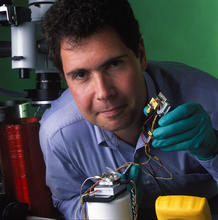
NIST physicist John Kitching holds six patents, including one that has influenced the development of commercial products (see main text section on patents), and has received a variety of awards. He is self-motivated to invent.
“One of my favorite phrases is ‘What if…?’,” Kitching says. “What if we tried this approach? What if we put these two things together? What if we were able to get this thing to work?”
“I love the Linus Pauling quote: ‘If you want to have good ideas you must have many ideas. Most of them will be wrong and what you have to learn is which ones to throw away.’ This is always how innovation has worked for me. I have had far, far more bad ideas than good ones.”
To encourage invention, institutions need to encourage risk-taking and acceptance of failure without negative consequences, balanced with accountability requiring successful outputs, Kitching says. Long-term investment is needed in promising novel ideas that could solve important problems, he adds.
“NIST is a truly wonderful place that has done so much for me,” Kitching says. “NIST does pretty well in letting people run with projects and explore what interests them without too much management interference. That’s a good thing. The biggest challenge NIST faces, in my opinion, is that we don’t have a culture in which technology innovation leading to products is valued as much as our absolutely world-class basic science.”
Notably, NIST’s culture of innovation and public service is strong and longstanding enough to attract inventors from other institutions as guest researchers.
Patents and licenses tell only part of the overall NIST tech transfer story. A 2017 study found that “NIST’s impact on invention is at least two orders of magnitude [100 times] greater than indicated by only counting NIST-assigned patents.” That’s because NIST innovations are often transferred to users in other ways.
For example, NIST innovations may be commercialized without being patented. NIST recently was awarded a patent for a phantom, a stand-in for human tissues, for calibrating magnetic resonance imaging (MRI) machines that is traceable to standardized values. But even before the patent was awarded, NIST’s MRI phantoms were rapidly transferred to industry. More than 120 NIST-developed phantoms of three types have been sold to more than 100 institutions worldwide, including major medical equipment manufacturers and top research hospitals.
The 2017 study found that NIST has impacts on inventive activity through many channels. The study found “substantial usage of NIST science” in the form of over 34,000 patent references to NIST research outputs between 1970 and 2015. Patent citations are a commonly used indicator of innovation and technological impact.
Specifically, 197 patents assigned to NIST were cited over 2,000 times; 54,066 NIST peer-reviewed journal papers were cited 14,538 times as prior art in patents; and NIST gray literature (such as SRMs, software, NIST technical reports) generated 8,468 patent citations. The number of annual citations overall has been rising in recent years.
NIST Inventor: Jacob Rabinow (1910-1999)
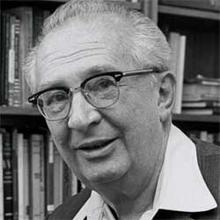
NIST’s most famous inventor is engineer Jacob Rabinow, who holds 230 U.S. patents and 70 foreign patents. He was inducted into the Inventors Hall of Fame. A collection of his inventions is on exhibit in the NIST Museum’s Rabinow Room.
The museum website describes Rabinow as “one of the most creative, dedicated, wide-ranging, productive, and colorful civil servants ever to grace the offices and laboratories of the United States Government.”
He holds patents for inventions such as the automatic regulation of clocks used in all American automobiles, the automatic letter-sorting machine still used by the U.S. Post Office, and the magnetic particle clutch now used in airplanes.
“I believe that inventions are particularly important for the general welfare of a great nation,” Rabinow wrote in his 1990 book, Inventing for Fun and Profit.
Another channel for NIST impacts is the cooperative research and development agreement (CRADA). These agreements are effective ways of sharing skills and tools and transferring know-how and technologies. In FY 2017, NIST was involved in 2,899 active CRADAs, which include traditional collaborative research and development projects as well as “nontraditional” CRADAs, for example for calibration services. CRADA data such as licensing and commercialization is generally negotiated to be confidential for a period of time after conclusion of the agreement, to protect proprietary scientific, business or financial information — sometimes limiting an agency’s ability to take credit for a successful transfer.
For example, a CRADA is being signed to commercialize the first patented output from the NIST on a Chip program, an optical thermometer that eliminates the current thermometry problem of measurement drift due to mechanical shock. However, the CRADA details are not public.
The NIST on a Chip program — expected to revolutionize the way NIST supports industry with small, low power devices at modest cost that can be used almost anywhere, anytime — will be a testbed for new ideas in technology transfer. These ideas include identifying the right partners at the right time and making it easy for them to work with NIST. The pilot program aims to encourage the development of commercialized products.
Spinoff Companies
NIST has provided the basis for not only commercial products but also entire companies.
For example, entrepreneur Chris Myatt was a graduate student at JILA and did his postdoctoral work at NIST. He has founded two successful technology companies, one of which was sold to a conglomerate. He used know-how from both NIST and JILA and credits their great science for providing him with top-notch staff hires and an important investor. His second company’s rapid, point-of-care medical testing device is based on novel optical spectroscopy and detection techniques that he learned at NIST. (More JILA-associated spinoffs can be found in JILA: The First 50 Years, 1962-2012, on Page 88.)
Another spinoff company that credits NIST for contributing to its success is led by former NIST researcher Kam Lau. In the 1980s, Lau developed the first laser tracking interferometer combined with a servo system that allows the laser to track a moving target and measure the distance and angle of the target. Lau’s company now sells these systems for use in large-scale precision manufacturing, particularly in aerospace, but also in the automotive, shipbuilding, machine tool, robotic, heavy industry and energy sectors.
NIST began an effort to encourage entrepreneurship among former staff and postdocs in 2015 with the creation of the NIST–Science and Technology Entrepreneurship Program (N-STEP), which helps NIST researchers explore entrepreneurial careers. The program, which is administered by the Maryland Technology Development Corporation (TEDCO), is focused on commercialization of NIST research as products or services to benefit the public. Since N-STEP made its first award in 2016, nine spinoff companies have been funded, with some already selling products.
Journal Papers and Gray Literature
NIST staff publish a lot. In FY 2017, NIST staff wrote 1,433 publications in peer-reviewed journals, including 406 papers (28 percent) published in 110 "top tier" journals. NIST researchers also collaborated and co-wrote with 5,464 non-NIST authors from 1,334 other institutions in 67 countries.
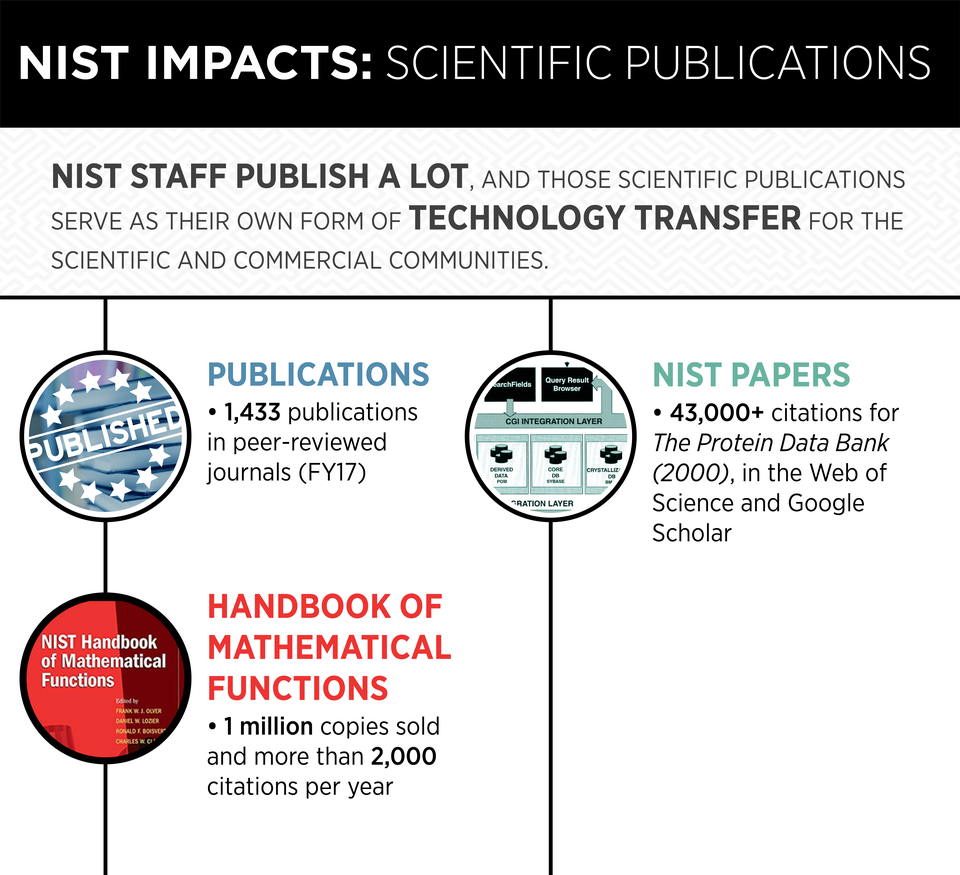
NIST publications are very influential. In fact, NIST peer-reviewed and technical publications are responsible for over 90 percent of NIST’s impact on invention and innovation, according to one study.
In that study of citations in patents between 1970 and 2015, 54,066 NIST peer-reviewed journal papers were cited 14,538 times as prior art in patents, and NIST gray literature (such as SRMs, software and technical publications) generated 8,468 patent citations. Patent citations to NIST technical output grew strongly between 1999 and 2014, mostly driven by NIST publications, not NIST patents. For instance, citations to NIST gray literature grew almost ninefold during that time.
The study noted that some papers are highly cited by other publications, an indicator of scientific impact, but not necessarily cited as prior art in patents, an indicator of innovation and technological impact. The reverse is also true.
The most highly cited NIST journal paper is The Protein Data Bank, published in 2000, cited 17,878 times in the Web of Science and 26,046 times in Google Scholar, according to data collected by NIST library staff. The bank of molecular structures has proved valuable in a growing number of research fields including biology, biochemistry and drug discovery.
Another testament to NIST’s influence is innumerable awards, including five Nobel Prizes in the past 20 years. The Nobel-honored technical advances, such as the first Bose-Einstein condensate (BEC), have led to at least one new company, and the BEC journal paper is NIST’s second-most-cited journal paper ever.
NIST/JILA physicists Jun Ye and the late Deborah Jin have consistently been among the most frequently cited researchers in the world. In a Thomsen Reuters ScienceWatch analysis of more than 12,000 quantum computing research papers published from 1999 to 2009, NIST ranked among the top 15 of 2,661 institutions worldwide in terms of numbers of papers, citations, and citations per paper. Many of these papers were the work of Nobel laureate David Wineland, who also has one patent and was elected a fellow of the National Academy of Inventors. (Further evidence of his influence: Wineland started one of the first ion-trapping research groups in the late 1970s; today there are 85 such groups around the world.)
NIST’s influential gray literature also includes technical reports and software tools. The bestseller is the Handbook of Mathematical Functions, first published in 1964 and recently updated in digital format. The handbook is NIST’s most widely cited publication of all time. The 1964 volume sold an estimated 1 million copies and still averages more than 2,000 citations per year, according to the NIST library.
NIST technical reports can have human impact. For example, tens of millions of people benefit annually from NIST expertise in usability and biometrics in border security and airport environments. A NIST study determined that fingerprint scanners used for foreign nationals entering the United States were best positioned at angles of 20 or 30 degrees, and the 20 degree option was chosen. As a result, all fingerprint scanners at U.S. ports of entry are now angled correctly for the collection process. An estimated 80 million foreign nationals visited the country in 2018.
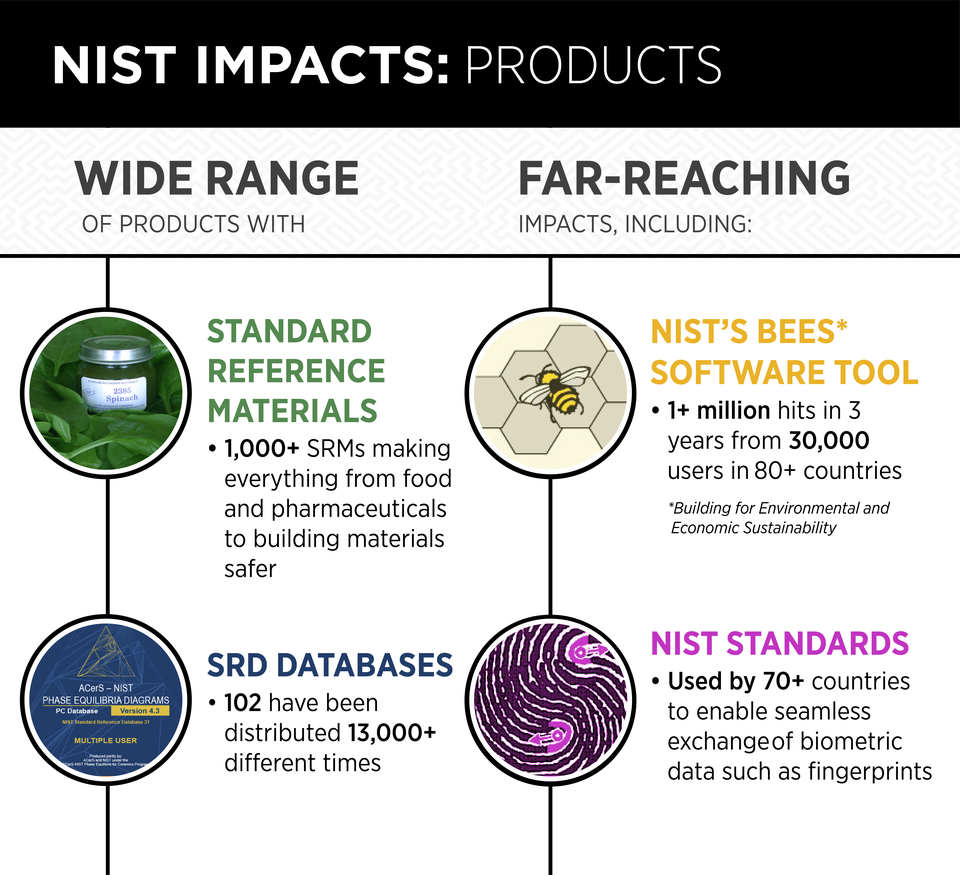
A popular software tool is Building for Environmental and Economic Sustainability (BEES), which measures the environmental performance of more than 230 building materials and more than 100 bio-based products. In 2010 BEES had nearly 30,000 users from more than 80 countries. The BEES website received more than 1 million hits in three years, making it one of NIST’s most popular. During 2018 there were 142,905 hits on the BEES site, including 73,157 new visitors and 69,748 returning visitors.
NIST standards activities also have wide impact. For example, border security, crime investigations, background checks and access control all rely on a NIST-led standard enabling seamless exchange of biometric data such as fingerprints. The Department of Defense, the Federal Bureau of Investigation, the Department of Homeland Security, Interpol and the governments of 70 countries use the standard to support law enforcement and border security.
“On a daily basis we are uploading NIST-format files of fugitives and internationally wanted persons, and through searching in member countries we are able to identify these persons. International fugitives and wanted persons are being caught on a daily basis due to the increased sharing of fingerprint images as NIST-format files.” —Mark Branchflower, Head of Fingerprint Unit, Police Forensics Sub-Directorate, Interpol General Secretariat, France, October 2018
Standards contribute significantly to economic growth and are integral to innovation. NIST’s Standard Reference Data (SRD) program provides critically evaluated numeric data to scientists and engineers for use in technical problem solving, research and development. NIST currently maintains 102 SRD databases. In FY 2017, the program distributed 2,229 e-commerce orders, 7,995 units sold via distributor, 154 active distributor agreements, 36 active site licenses, 40 active internet subscriptions, 328 units shipped to the user, and 3,119 products downloaded from the NIST website (1,225 free downloads, 1,894 paid downloads).
Valuable information is also disseminated through more than 100 NIST-hosted conferences attracting thousands of outside researchers annually. NIST’s ongoing Text REtrieval Conference (TREC) has contributed to the development of search engines and even helped fine-tune the supercomputer Watson, which won the TV game show Jeopardy in 2011. That game was worth a million dollars to the winner.
NIST Extramural Programs
Studies of NIST’s extramural programs have demonstrated strong economic impact.
The Hollings Manufacturing Extension Partnership program works in all 50 states to bring services to small and midsized manufacturers to make them more competitive. For every $1 of federal investment, the MEP generates nearly $30 in new sales growth and $20 in new client investment. This translates into $3.8 billion in new sales annually. For every $1,065 of federal investment, MEP creates or retains one manufacturing job.
The MEP reports over a thousand success stories in the past three years. Companies report benefits such as doubling capacity or product output, opening new markets, adding jobs and customers, reducing costs and scrap, and boosting morale and efficiency.
The Baldrige Performance Excellence Program recognizes the most outstanding and highest-performing organizations in the country and disseminates their best practices so that other businesses, nonprofits, school systems, and health care systems can be better, too. Among the program’s positive impacts, two major health care surveys found that hospitals that adopt and use the Baldrige Criteria for Performance Excellence have successful operations, management practices and overall performance — including better health outcomes for their patients. A 2012 economic impact study found the benefits of the program outweigh the overall cost by 820 to 1.
Boosting NIST’s Impact and Recognition
Efforts are already underway to make it easier to commercialize innovations from all federal labs. The findings in a NIST “green paper,” published in its final form on April 24, 2019, identify ways to modernize technology transfer, such as streamlining federal regulations, enabling greater flexibility and building a more entrepreneurial workforce. And technology transfer from federal agencies to the private sector has been increasing in recent years.
NIST Inventor: Laurie Locascio

Laurie Locascio, a biomedical engineer who is a former director of NIST’s Material Measurement Laboratory and now vice president for research at the University of Maryland, has the most patents of all current and recent NIST staff. She holds nine patents, mostly for microfluidics.
A few of these patents were licensed and used in marketed products such as magnetic connectors for microfluidic plumbing (see Page 16 at the link) that greatly simplified the development and use of fluidic chips for a variety of applications, Locascio says. Some of the research developments led to other independent patents that motivated one of her former colleagues to spin off a company and become an entrepreneur.
“While I was at NIST, I found the culture to be wonderfully creative,” Locascio says. “In my 30 years at NIST, there were times when invention and the inventor were valued and times when not valued — yet the culture of excellence in deep scientific research and technology advancement led naturally to publication and patenting.
“Some of the happiest and most inspiring times for me at NIST were brainstorming and problem solving with my small but brilliant team of diverse researchers that I was privileged to lead. Those were intensely creative and prolific times, and most of my patents were a product of those years.”
Now, NIST Director Copan is working to remove barriers to even more transfer of federal innovations from the laboratory to market.
His efforts include capturing intellectual property rights (publishing, patenting, trademarks), maximizing the impact of outside collaborations, encouraging business development of NIST research, expanding the programmatic base through partnerships, and creating entrepreneurial opportunities.
For example, NIST is streamlining the tech transfer process, making it faster and easier for researchers to use. The process for providing patenting recommendations to NIST management has been streamlined, and an online invention disclosure process is planned.
NIST also revised its standard CRADA to expedite review and cut the length of the process by about a third. NIST also implemented several new licensing programs to encourage small businesses to participate. These programs lay out terms in advance to ease cost concerns. For example, the Science/Technology Advancement Research (STAR) license provides a no-cost, nonexclusive field-of-use research license to explore and advance NIST technologies for commercialization.
The efforts are starting to pay off. As mentioned earlier, N-STEP has funded nine NIST spinoff companies.
“I would welcome more applications,” says Ronald Kaese, director of federal programs for TEDCO. “This is the best deal I have ever seen offered for a startup company. The N-STEP award comes with technology, access to unique facilities and equipment, seed funds and help with business acumen. Add to that, this is a program that has already been proven to work by recent N-STEP award recipients.”
In fiscal year 2018, NIST logged 72 new invention disclosures, nearly twice as many as the 40 reported for the previous fiscal year.
NIST is also co-leading the Return on Investment Initiative, which has a goal of maximizing federal investments in science and technology. The effort seeks to attract greater private sector investment in creating new products and services from the results of federally funded R&D.
Finally, Copan wants to ensure that NIST gets credit where it’s due.
“One of my goals is to see that NIST gets increasingly recognized for the products of its research that have an impact on our economy,” Copan says.

